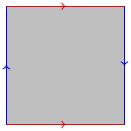5.01 Van Kampen's theorem
Below the video you will find accompanying notes and some pre-class questions.
- Next video: Fundamental group of a CW complex.
- Index of all lectures.
Notes
Van Kampen's theorem
(2.33) Given \(A,B,C,f,g\), you can define the amalgamated product \[A\star_C B=\langle\mbox{generators of }A,\ \mbox{generators of }B\ | \mbox{ relations of }A,\mbox{ relations of }B,\mbox{ amalgamated relations}\rangle.\] The amalgamated relations come from elements \(c\in C\): each \(c\in C\) gives a relation \(f(c)=g(c)\).
Amalgamated relations
(4.30) What does this mean? We have \(f(c)\in A\) and we have already in the presentation of \(A\star_C B\) the generators and relations of \(A\), so I can make sense of the element \(f(c)\) in the amalgamated product. Similarly, \(g(c)\in B\) and we can think of this as an element in the amalgamated product. The corresponding amalgamated relation is just saying that these two elements agree.
(5.13) Geometrically, in the context of Van Kampen's theorem, \(C\) consists of loops living in the intersection \(U\cap V\); the amalgamated relations are then saying ``you can think of these loops as living in \(U\); you can think of them living in \(V\); it makes no difference''.
Examples
We have \(\pi_1(U)=\pi_1(V)=\{1\}\) as both \(U\) and \(V\) are simply-connected discs. Since \(U\cap V\) is homotopy equivalent to the circle, \(\pi_1(U\cap V)=\mathbf{Z}=\langle c\rangle\) (i.e. one generator, \(c\), and no relations).
The amalgamated product \(\pi_1(U)\star_{\pi_1(U\cap V)}\pi_1(V)\) has the empty set of generators coming from \(\pi_1(U)\) and the empty set of generators coming from \(\pi_1(V)\). Therefore it has no generators and the amalgamated product is trivial.
(9.07) The fact that \(\pi_1(U\cap V)\) is nontrivial doesn't affect this computation: it would only enter into the relations in the group. Indeed, for each \(c\in\pi_1(U\cap V)\), we have \(i_*c=1\in\pi_1(U)\) and \(j_*c=1\in\pi_1(V)\), so the amalgamated relations all become \(1=1\), which we don't need to include as a relation because it holds in any group.
The upshot of all of this is the statement that \(\pi_1(S^2)=\{1\}\).
(10.37) Since \(U\simeq S^1\) and \(V\simeq S^1\) we have \(\pi_1(U)=\pi_1(V)=\mathbf{Z}\). Moreover, \(U\cap V\) is contractible, so \(\pi_1(U\cap V)=\{1\}\). The amalgamated product has a generator \(a\) coming from \(\pi_1(U)\) and a generator \(b\) coming from \(\pi_1(V)\). There are no relations coming from \(\pi_1(U)\), none coming from \(\pi_1(V)\) and also no amalgamated relations (since \(\pi_1(U\cap V)\) is trivial).
(11.57) A presentation for \(\pi_1(S^1\vee S^1)\) is therefore \[\langle a,b\rangle\]. This has no relations: we call a group with no relations a free group on its generators. The elements of a free group \(\langle a,b\rangle\) are words on its generators, written using \(a\)s, \(b\)s, \(a^{-1}\)s, \(b^{-1}\)s, for example \[a^2b^{-1}a^{14}bab^2.\] The only simplifications one may perform with these elements are things like \(aa^{-1}=a^{-1}a=1\) or \(bb^{-1}=b^{-1}b=1\). In particular, the free group on two generators is not abelian (the relation \(ab=ba\) does not hold).
- \(\pi_1(U)\) is trivial, as \(U\) is a disc;
- \(\pi_1(U\cap V)=\mathbf{Z}\);
- \(\pi_1(V)=\langle a,b\rangle\), as \(V\simeq S^1\vee S^1\).
(16.03) Van Kampen's theorem then tells us \(\pi_1(T^2)=\langle a,b\ |\ i_*(c)=j_*(c)\rangle\), where
- \(c\in\mathbf{Z}\) is a generator,
- \(i_*\colon\mathbf{Z}\to \{1\}\) is the trivial map,
- \(j_*\colon\mathbf{Z}\to\langle a,b\rangle\) sends a generator
for \(\mathbf{Z}\) to some word in \(a,b\)
(18.00) This relation is equivalent to \(ab=ba\), so the group we get is just the abelian group \(\mathbf{Z}^2\).
Pre-class questions
- The Klein bottle \(K\) is obtained from a square by identifying
opposite sides as in the figure below. By mimicking the calculation
for \(T^2\), find a presentation for \(\pi_1(K)\) using Van
Kampen's theorem.

Navigation
- Next video: Fundamental group of a CW complex.
- Index of all lectures.